This was published 9 years ago
Cruise on the Middle Rhine in Germany a charming way to travel
The Middle Rhine is one of Europe’s most historic and scenic stretches of water, and there’s no better way to appreciate it than on a river cruise.
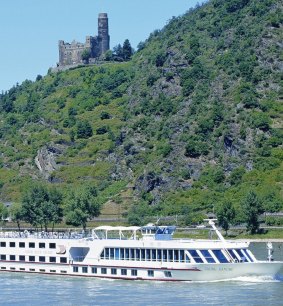
Castles galore: Passengers on a Viking Longship can look up to see the Maus Castle. Credit: Viking River Cruises
The engines of Viking Var rumble and, with a toot of the ship's horn, we're off again. I stand on deck, shading my eyes, as we sail out of Rudesheim. Vineyards cling to the hillsides and a castle tower crumbles. Ahead, the entrance to the Rhine gorges gapes. For centuries, this stretch of river has tantalised travellers, invited poetry and song, and lured traders with the promise of riches. As a waiter carries out a cold beer and I settle onto my deck chair, I anticipate a memorable day.
Any cruise down a European river is a fine way to travel, and perhaps nowhere more so than on this section of the Middle Rhine as it flows through Germany between the wine village of Rudesheim and the town of Koblenz. In all truth, the rest of the Rhine has wonderful culture and cities but no grand scenery: the passing landscape is either flat or industrial, and often both. The Rhine gorges are different and the highlight of any journey. Mediaeval villages, vineyards and a fine collection of castles flow past the ship on a stretch of river that has been long celebrated. Goethe was entranced by the Rhine's romance, Wagner wrote operas about the river's mythical Nibelungen race, and Turner captured is misty sunsets in paint. You can visit the Middle Rhine by road or rail, of course, but a river journey best captures its essence as you float not just through space, but culture and history too.
My Viking river cruise starts in Basel in Switzerland and finishes in Amsterdam. It takes in almost the entire navigable length of this famous river. We dock at Rudesheim on the afternoon of the fifth day, and I spend my free time on a tour of Siegfried's Mechanical Musical Cabinet, a rather curious museum of automated musical instruments. It proves to be fascinating and amusing, with everything from quaint musical boxes to mechanical violins and barrel organs that hoot and thunder.
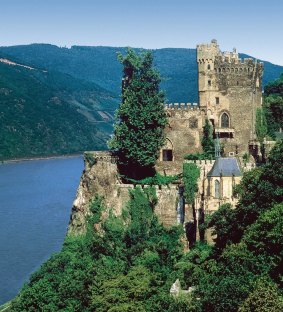
Stunning: Rheinstein Castle on the banks of the Rhine.Credit: German National Tourist Office
Later I walk up into the hills. Vineyards spread out around the town. Rudesheim sits in a wine-producing region famous for sekt, the sparkling wine that is Germany's answer to champagne. It's the most popular of several wine villages and can often get crowded with river-cruise passengers and residents from nearby Frankfurt. Cobbled lanes lined by leaning half-timbered houses are sometimes elbow-to-elbow, but I reckon the village's wine taverns are at their best when busy. That evening, brass bands compete with groups of singing revellers to create a maximum of oomph. I try some white wine with traditional accompaniments: cheese with vinegar, oil and finely chopped onions, accompanied by knee-slapping and singing.
Next day, as we sail into the gorges, it's easy to see how the region is so suited to the cultivation of grapes. Vineyards cling to well-drained slopes, get maximum sun from southern exposure, and are sheltered from cold north winds. The soil – according to our cruise director, who provides commentary over the PA system as we sail – contains quartz and slate that retain heat during the night.
Some of these vineyards have been producing wine since the 12th century, and it made the Middle Rhine rich on trade. As the Rhine wends its way through steep wooded hills and cliffs, each bend is guarded by another fortification perched on an inaccessible crag. Many have crumbled into ruin, but even their dilapidation is splendid. Burg Rheinstein, refashioned in high mediaeval style in the 19th century, is fanciful as a fairytale. Along the river lies Burg Sooneck; apparently you can stand on its terraces and see another seven castles.
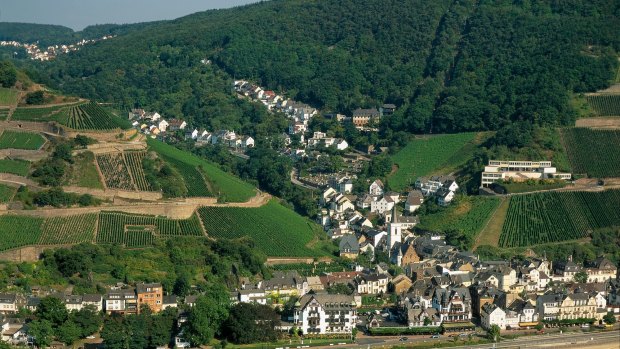
Wine region: Cruising the Rhine takes in the sights of Assmannshausen on its banks, renowned for its red wine. Credit: German National Tourist Office
You can't get views from on high on a river ship, but I do have the joy of admiring both riverbanks at once, and sometimes it's hard to know where to look. Passengers dart from one railing to another. As we sail past Oberwesel, fellow passengers click cameras: the town's 16 remaining mediaeval towers rise above the fortified town walls. Above, Burg Schonburg, although ransacked by the French in 1689 and never rebuilt, still has massive walls nearly two metres thick in places.
It's a glorious few hours in the sun, sailing past a string of vineyard villages punctuated by steep church spires and golden weather vanes. Earlier we passed Mouse Tower, standing on a small island, and learn it was built in the 13th century by a bishop who wished to extract customs taxes from the passing river traffic. The rapacious prelate grew so unpopular he was eventually forced to barricade himself in his own tower, dying alone.
The Middle Rhine is full of improbable stories. Just past the castle of Pfalz, the river valley narrows dramatically, producing swift currents and eddies hazardous to navigation, though now tamed by dynamiting. This gave rise to the legend of the Lorelei, a beautiful siren who lived in a cave on the cliff face and lured sailors to their doom with her singing. The legend was immortalised in a poem by Heinrich Heine. Later set to music, it's the unofficial anthem for the region. The song of Lorelei plays over the loudspeakers of Viking Var as we sail beneath the cliffs. The river swirls and gurgles as we pass majestically (and safely) onwards.
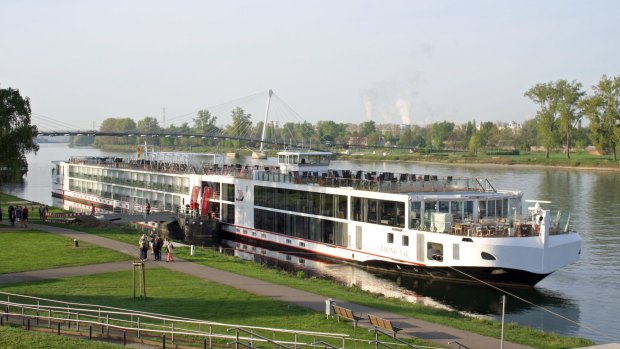
Way to cruise: The Viking Var, docked at Kehl, is a fine way to travel.Credit: Brian Johnston
At Boppard the river becomes more gentle. On some Rhine cruises, ships call in here so passengers can promenade along the waterfront and pop into the mediaeval Carmelite Church, where grotesque figures in wood grimace down from the choir stalls. Viking Var calls in at Marksburg instead, reached by coach on a corkscrewing road that showcases the driver's nimble skills. Built to guard surrounding silver and lead mines, Marksburg proved the most formidable of all the Rhine castles, and was never taken in battle. Its interior is unadorned, and its rooms too cramped for a tour group this size. We make a slow shuffle from dungeon to great hall, but there are splendid views from its battlements. The forested hilltops hint of wildness but, beneath, vines are neatly pegged and village houses smug with geraniums.
You know the Rhine gorges have ended when you see your first bridge as you sail into the large town of Koblenz. Koblenz lies at the meeting of the Rhine and Moselle rivers (or Mosel in German), and the river is busy with cruise ships and barges carrying goods into the heart of Europe from the ocean port at Rotterdam. One of its landmarks is the Rheinkran, a giant crane built on the riverbanks at the beginning of the 17th century to unload cargo.
Koblenz's convenient river location was noticed by the founding Romans, and the city grew powerful on trade in the Middle Ages. We tie up for the evening, allowing plenty of time for a look around the old town and adjacent shopping streets. But the best place to end the day is on the riverfront. There's a fine view across the Rhine to the massive bulk of Festung Ehrenbreitstein, one of the largest fortresses in Europe.
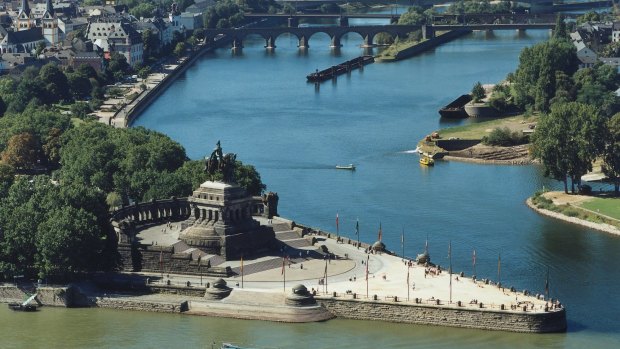
Spectacular: The meeting of the Rhine and Moselle rivers at Cologne. Credit: German National Tourist Office
At the intersection of the promenade and Pfaffendorfer Bridge I find the Weindorf or 'wine village' of taverns set in small gardens. It was originally set up in 1925 for an exhibition of German wines, but has been maintained as a lively tourist venue. Jazz brunches and summer evenings of live music mightn't quite be the song of the Lorelei, but I reckon they may seduce you anyway.
FAMOUS SITES
For many, the Middle Rhine gorges are the highlight (certainly the scenic highlight) of a Rhine river cruise, but the Basel-to-Amsterdam itinerary takes in other impressive sights too.
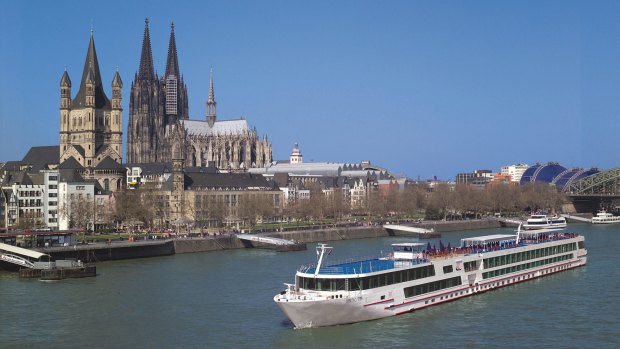
Drowning in scenery: The Viking Sun sails past Cologne on the Rhine, Germany.Credit: Viking River Cruises
Breisach, Germany
This rather charming little port town has wonderful views from its hilltop church terraces and is the jumping-off point for a visit to the rugged granite mountains of the Black Forest, with its baroque churches and cuckoo-clock workshops.
Strasbourg, France
The ship ties up at Kehl in Germany, and it's only a short coach ride across the bridge to Strasbourg, a lovely, flower-filled mediaeval city built on canals, notable for its Gothic cathedral and home to the European Parliament.
Heidelberg, Germany
At Mannheim, passengers disembark for a tour of Germany's oldest university town, topped by the sandstone ruins of Heidelberg castle high above the scenic Neckar Valley. The long pedestrian main street is lined by restaurants and shops.
Cologne, Germany
Walk from the ship straight into town to see one of Europe's largest and most incredible cathedral facades. The city also has great museums, shopping and nightlife and a very lively atmosphere.
Kinderdijk, Netherlands
This World Heritage site features a series of windmills used over the centuries for flood management. Learn how and why they were built on a guided tour, and clamber inside a working windmill to see how millers once lived.
The writer travelled as a guest of Viking River Cruises. Follow his river-cruise blog at rivercruiseinsight.com
GETTING THERE
Etihad flies to Abu Dhabi (14.5hr) with onward connections to Zurich (7hr), an hour from Basel by train. Return economy fare from $1953 from Melbourne and $1969 from Sydney low season, including taxes. The airline also flies to Amsterdam. Phone 1300 532 215, see etihad.com.
CRUISING THERE
Viking River Cruises' eight-day "Rhine Getaway" cruise between Basel and Amsterdam is priced from $3195 a person twin share, including meals and guided shore excursions. Several other itineraries also pass through the Rhine gorges. Phone 1800 829 138, see vikingcruises.com.au.
MORE INFORMATION
Sign up for the Traveller Deals newsletter
Get exclusive travel deals delivered straight to your inbox. Sign up now.